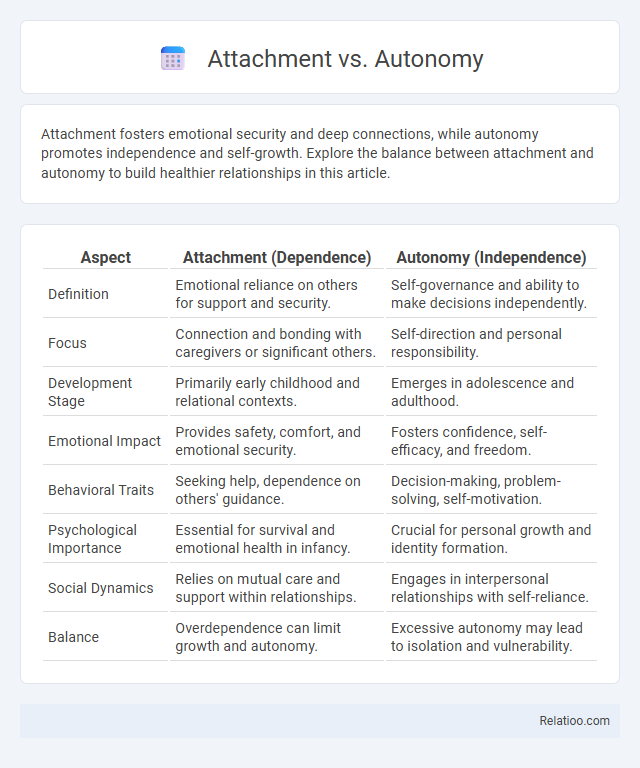Attachment fosters emotional security and deep connections, while autonomy promotes independence and self-growth. Explore the balance between attachment and autonomy to build healthier relationships in this article.
Table of Comparison
| Aspect | Attachment (Dependence) | Autonomy (Independence) |
|---|---|---|
| Definition | Emotional reliance on others for support and security. | Self-governance and ability to make decisions independently. |
| Focus | Connection and bonding with caregivers or significant others. | Self-direction and personal responsibility. |
| Development Stage | Primarily early childhood and relational contexts. | Emerges in adolescence and adulthood. |
| Emotional Impact | Provides safety, comfort, and emotional security. | Fosters confidence, self-efficacy, and freedom. |
| Behavioral Traits | Seeking help, dependence on others' guidance. | Decision-making, problem-solving, self-motivation. |
| Psychological Importance | Essential for survival and emotional health in infancy. | Crucial for personal growth and identity formation. |
| Social Dynamics | Relies on mutual care and support within relationships. | Engages in interpersonal relationships with self-reliance. |
| Balance | Overdependence can limit growth and autonomy. | Excessive autonomy may lead to isolation and vulnerability. |
Understanding Attachment: Foundations and Functions
Understanding attachment involves recognizing its foundational role in emotional bonding and survival instincts, where secure attachments provide safety and emotional regulation essential for healthy development. Attachment functions as a psychological blueprint influencing interpersonal relationships, guiding responses to stress, and shaping social competence across the lifespan. Research in developmental psychology highlights how early caregiver interactions form attachment styles that impact autonomy and nurturance capacities in adulthood.
The Essence of Autonomy in Personal Development
Autonomy in personal development signifies an individual's capacity for self-governance, decision-making, and independent thinking, essential for cultivating self-confidence and resilience. It involves balancing internal motivations with external influences, allowing one to develop authentic goals aligned with personal values. Autonomy empowers individuals to navigate life's challenges proactively while fostering emotional growth through self-awareness and responsibility.
Key Differences between Attachment and Autonomy
Attachment involves the emotional bond and reliance you develop with caregivers, emphasizing security and connection. Autonomy centers on your ability to act independently and make decisions without undue reliance on others. The key difference lies in how attachment prioritizes relational dependence, while autonomy highlights self-governance and personal freedom.
Psychological Theories on Attachment and Autonomy
Attachment theory, pioneered by John Bowlby, emphasizes the importance of early bonds formed between infants and caregivers as foundational for emotional security and social development. Autonomy, deeply explored in Self-Determination Theory by Deci and Ryan, highlights the intrinsic need for individuals to feel volitional and self-endorsed in their actions, promoting psychological growth and well-being. Integrating these perspectives, modern psychological research suggests that secure attachment supports autonomy development by providing a safe base from which individuals explore and assert independence.
Attachment Styles: Impact on Relationships and Independence
Attachment styles, such as secure, anxious, and avoidant, significantly influence relationship dynamics and individual autonomy. Secure attachment fosters healthy interdependence, promoting trust and emotional regulation, while anxious attachment often leads to dependency and fear of abandonment, undermining independence. Avoidant attachment encourages emotional detachment and self-reliance, which can impair intimacy but enhance personal autonomy.
Autonomy Across the Lifespan: Childhood to Adulthood
Autonomy across the lifespan evolves from early childhood, where developing decision-making skills and independence lays the foundation for self-regulation, to adulthood, where autonomy involves complex choices regarding personal values, career, and relationships. Your ability to balance autonomy with attachment nurtures healthy emotional development, promoting resilience and psychological well-being. Understanding nurturance supports this growth by providing the emotional support necessary to explore independence confidently throughout life stages.
Balancing Attachment and Autonomy: Myths and Realities
Balancing attachment and autonomy involves understanding that secure connections do not hinder independence but rather support it by providing a safe foundation for exploration. You can foster healthy relationships by recognizing that nurturing attachment promotes emotional security, which in turn encourages confident autonomy. Dispelling myths that attachment breeds dependency clarifies the reality that these two dimensions coexist and enhance personal growth.
Cultural Perspectives on Attachment vs. Autonomy
Cultural perspectives shape Attachment and Autonomy by emphasizing collectivist values like interdependence in many Asian and Latin American societies, where close family bonds and nurturance are prioritized. In contrast, Western cultures often promote autonomy and individualism, encouraging self-reliance and personal independence from an early age. Understanding these cultural differences helps you navigate the balance between fostering secure attachments and supporting your own or others' autonomy within diverse social contexts.
Navigating Conflicts: Attachment Needs vs. Autonomy Goals
Navigating conflicts between attachment needs and autonomy goals requires balancing emotional closeness with individual independence in relationships. Attachment emphasizes secure emotional bonds and responsiveness, while autonomy promotes self-direction and personal growth, often leading to tensions when closeness is perceived as controlling. Effective conflict resolution involves open communication that respects both partners' desires for connection and space, fostering mutual understanding and adaptive compromises.
Fostering Healthy Attachment and Autonomy in Daily Life
Fostering healthy attachment and autonomy in daily life involves balancing emotional support with opportunities for independent decision-making, which nurtures secure relationships and self-confidence. Consistent responsiveness to a child's needs promotes attachment security, while encouraging problem-solving and choice fosters autonomy. Integrating nurturing behaviors with respect for individuality creates a foundation for emotional well-being and adaptive functioning.

Infographic: Attachment vs Autonomy
 relatioo.com
relatioo.com